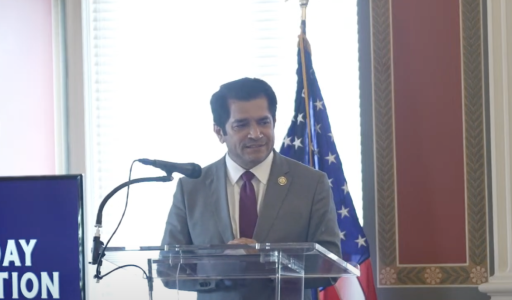Could Medicare be expanding? Here’s what the new "Part E" proposal might mean for you
By
Veronica E.
- Replies 0
There’s a new conversation taking shape in Washington, and it could have major implications for millions of Americans—including many in our GrayVine community.
Lawmakers have reintroduced the Choose Medicare Act, a bold proposal aimed at expanding access to Medicare far beyond its current scope.
If passed, it could offer more choices not only for retirees but also for younger individuals who struggle to find affordable coverage.
Whether you're already enrolled, approaching eligibility, or concerned about a loved one’s insurance, this bill could represent a significant shift.
Let’s take a closer look at what’s being proposed, how it could affect you, and what to watch for in the coming months.

A new vision for Medicare: What is "Part E"?
Since 1965, Medicare has served as a lifeline for older adults and people with certain disabilities.
But what if the program didn’t just start at age 65? What if anyone—regardless of age, employment status, or health—could choose to enroll?
That’s the premise behind the newly proposed Medicare Part E, championed by Democratic lawmakers including Senators Jeff Merkley (OR) and Chris Murphy (CT), and Representatives Jimmy Gomez (CA) and Don Beyer (VA).
Their bill envisions a public health insurance option available to all Americans and businesses—right alongside private plans on the state and federal marketplaces.
This new plan wouldn’t replace traditional Medicare or employer-sponsored insurance.
Instead, it would offer another choice—a self-funded public option that emphasizes affordability, comprehensive care, and accessibility.
Also read: Medicare price talks progress quietly as government targets costly prescriptions
Why now? Understanding the stakes
Even with the Affordable Care Act in place, far too many Americans remain uninsured or underinsured.
Healthcare costs remain one of the leading causes of financial hardship, and a single health emergency can leave families reeling.
The Choose Medicare Act aims to address these issues by:
And it doesn’t stop there.
The proposal would also cap out-of-pocket costs for traditional Medicare recipients, expand eligibility for premium assistance, and allow ACA subsidies to be used toward Part E premiums.
Notably, Part E would require Medicare to negotiate drug prices, a long-awaited move that could finally help lower prescription costs across the board.
Also read: Medicare grocery allowance: Are you missing out on this food benefit?
How would Medicare Part E actually work?
Unlike current Medicare programs, Part E would be fully funded by the premiums paid by its enrollees, ensuring no additional strain on the Medicare trust fund.
Anyone could sign up through existing state or federal insurance exchanges, making enrollment as accessible as buying a private plan.
Employers could offer it as a coverage option alongside current group insurance, and individuals without workplace coverage could buy in directly.
The intent is to boost competition, expand coverage options, and lower costs for everyone involved.
Also read: A new bill could save 700,000 seniors from lifelong Medicare penalties—here’s what’s at stake
Support and skepticism: Who’s backing the bill—and who isn’t?
Several major advocacy groups have voiced strong support for the bill, including Families USA, MoveOn, the American Federation of Teachers, and the Center for Medicare Advocacy.
Supporters say Medicare already has a proven track record—and giving more people the opportunity to choose it just makes sense.
Rep. Jimmy Gomez, who co-sponsored the bill, drew from personal experience, saying: “Our legislation lets every American opt into Medicare—which is affordable, effective, and trusted—and we’re going to keep fighting until everyone has access to the care they need.”
However, not everyone is on board.
Chris Fong, CEO of Smile Insurance and a Medicare expert, warns that the proposal may be “romanticizing” Medicare.
He points out that traditional Medicare still requires enrollees to cover around 20% of costs and often lacks out-of-pocket limits.
Prescription drug coverage also requires separate plans—something Part E would need to address more clearly.
Fong also raises concerns about long-term funding.
"An expansion of Medicare with Part E could increase the concerns over the long-term financial sustainability of the Medicare program. The Medicare Hospital Insurance trust fund is projected to be depleted by 2036. If Part E were to be approved, then there would need to be additional funding to maintain the current Medicare benefits."

Also read: Health insurers’ rates skyrocket for Medicare–what this means for your wallet!
The political road ahead: Is this bill likely to pass?
As exciting as the proposal may be, its path through Congress won’t be easy.
With Republicans currently controlling both the House and Senate, the Choose Medicare Act faces steep opposition.
Many GOP lawmakers are focused on cutting federal spending—and while few are openly calling to reduce benefits for current recipients, they remain wary of expanding public programs.
Senator Bill Cassidy (R-LA) emphasized the need for reform: “Is there some way that we can...reform Medicare so that benefits stay the same? But that is less expensive, more efficient?”
Expect debate, proposed amendments, and plenty of negotiation if this bill gains traction.
What this means for you—now and in the future
If you’re already enrolled in Medicare, there’s no immediate change to your coverage.
This is a new, optional plan, not a replacement.
But it’s a conversation worth following, especially as future changes to Medicare are debated and shaped by public input.
If you’re not yet eligible or have family members struggling with affordable healthcare, this bill could offer new hope.
Imagine being able to choose a trusted public option—at any age, with transparent pricing and comprehensive benefits.
Also read: On Medicare and headed out of town? What to know before a medical emergency hits
Looking at the bigger picture: Medicare’s evolving role
For nearly 60 years, Medicare has offered protection and peace of mind to older Americans.
But in today’s healthcare landscape, there’s growing pressure to modernize and expand options.
Whether you believe in expanding public insurance, maintaining private competition, or exploring something entirely new, it’s clear that the national conversation is evolving.
And proposals like the Choose Medicare Act are helping to bring those big questions to the forefront.
Read next: Budget dilemma: Proposed cuts could hit Medicare and Medicaid, affect millions

What’s your opinion on Medicare Part E? Would you support a public option like this? Do you think it would ease costs for Americans, or raise concerns about sustainability and efficiency? Let us know in the comments!
At The GrayVine, we believe that real change starts with informed, thoughtful discussions—and that your experiences can help shape the future of healthcare policy.
Lawmakers have reintroduced the Choose Medicare Act, a bold proposal aimed at expanding access to Medicare far beyond its current scope.
If passed, it could offer more choices not only for retirees but also for younger individuals who struggle to find affordable coverage.
Whether you're already enrolled, approaching eligibility, or concerned about a loved one’s insurance, this bill could represent a significant shift.
Let’s take a closer look at what’s being proposed, how it could affect you, and what to watch for in the coming months.

The proposed Medicare Part E plan could give Americans of all ages a new public health insurance option—reshaping how families access and afford care. Image Source: Pexels / Tara Winstead.
A new vision for Medicare: What is "Part E"?
Since 1965, Medicare has served as a lifeline for older adults and people with certain disabilities.
But what if the program didn’t just start at age 65? What if anyone—regardless of age, employment status, or health—could choose to enroll?
That’s the premise behind the newly proposed Medicare Part E, championed by Democratic lawmakers including Senators Jeff Merkley (OR) and Chris Murphy (CT), and Representatives Jimmy Gomez (CA) and Don Beyer (VA).
Their bill envisions a public health insurance option available to all Americans and businesses—right alongside private plans on the state and federal marketplaces.
This new plan wouldn’t replace traditional Medicare or employer-sponsored insurance.
Instead, it would offer another choice—a self-funded public option that emphasizes affordability, comprehensive care, and accessibility.
Also read: Medicare price talks progress quietly as government targets costly prescriptions
Why now? Understanding the stakes
Even with the Affordable Care Act in place, far too many Americans remain uninsured or underinsured.
Healthcare costs remain one of the leading causes of financial hardship, and a single health emergency can leave families reeling.
The Choose Medicare Act aims to address these issues by:
- Letting anyone voluntarily enroll in Medicare Part E, regardless of age or employment
- Allowing businesses to offer Part E as a workplace health plan
- Providing full coverage of both traditional Medicare benefits and the ACA’s essential health benefits
- Guaranteeing access to reproductive healthcare, including abortion
- Protecting individuals with pre-existing conditions from discrimination
And it doesn’t stop there.
The proposal would also cap out-of-pocket costs for traditional Medicare recipients, expand eligibility for premium assistance, and allow ACA subsidies to be used toward Part E premiums.
Notably, Part E would require Medicare to negotiate drug prices, a long-awaited move that could finally help lower prescription costs across the board.
Also read: Medicare grocery allowance: Are you missing out on this food benefit?
How would Medicare Part E actually work?
Unlike current Medicare programs, Part E would be fully funded by the premiums paid by its enrollees, ensuring no additional strain on the Medicare trust fund.
Anyone could sign up through existing state or federal insurance exchanges, making enrollment as accessible as buying a private plan.
Employers could offer it as a coverage option alongside current group insurance, and individuals without workplace coverage could buy in directly.
The intent is to boost competition, expand coverage options, and lower costs for everyone involved.
Also read: A new bill could save 700,000 seniors from lifelong Medicare penalties—here’s what’s at stake
Support and skepticism: Who’s backing the bill—and who isn’t?
Several major advocacy groups have voiced strong support for the bill, including Families USA, MoveOn, the American Federation of Teachers, and the Center for Medicare Advocacy.
Supporters say Medicare already has a proven track record—and giving more people the opportunity to choose it just makes sense.
Rep. Jimmy Gomez, who co-sponsored the bill, drew from personal experience, saying: “Our legislation lets every American opt into Medicare—which is affordable, effective, and trusted—and we’re going to keep fighting until everyone has access to the care they need.”
However, not everyone is on board.
Chris Fong, CEO of Smile Insurance and a Medicare expert, warns that the proposal may be “romanticizing” Medicare.
He points out that traditional Medicare still requires enrollees to cover around 20% of costs and often lacks out-of-pocket limits.
Prescription drug coverage also requires separate plans—something Part E would need to address more clearly.
Fong also raises concerns about long-term funding.
"An expansion of Medicare with Part E could increase the concerns over the long-term financial sustainability of the Medicare program. The Medicare Hospital Insurance trust fund is projected to be depleted by 2036. If Part E were to be approved, then there would need to be additional funding to maintain the current Medicare benefits."

Representative Jimmy Gomez, a lead sponsor of the Choose Medicare Act, advocates for expanding access to affordable, trusted healthcare for all Americans. Image Source: YouTube / Rep Jimmy Gomez.
Also read: Health insurers’ rates skyrocket for Medicare–what this means for your wallet!
The political road ahead: Is this bill likely to pass?
As exciting as the proposal may be, its path through Congress won’t be easy.
With Republicans currently controlling both the House and Senate, the Choose Medicare Act faces steep opposition.
Many GOP lawmakers are focused on cutting federal spending—and while few are openly calling to reduce benefits for current recipients, they remain wary of expanding public programs.
Senator Bill Cassidy (R-LA) emphasized the need for reform: “Is there some way that we can...reform Medicare so that benefits stay the same? But that is less expensive, more efficient?”
Expect debate, proposed amendments, and plenty of negotiation if this bill gains traction.
What this means for you—now and in the future
If you’re already enrolled in Medicare, there’s no immediate change to your coverage.
This is a new, optional plan, not a replacement.
But it’s a conversation worth following, especially as future changes to Medicare are debated and shaped by public input.
If you’re not yet eligible or have family members struggling with affordable healthcare, this bill could offer new hope.
Imagine being able to choose a trusted public option—at any age, with transparent pricing and comprehensive benefits.
Also read: On Medicare and headed out of town? What to know before a medical emergency hits
Looking at the bigger picture: Medicare’s evolving role
For nearly 60 years, Medicare has offered protection and peace of mind to older Americans.
But in today’s healthcare landscape, there’s growing pressure to modernize and expand options.
Whether you believe in expanding public insurance, maintaining private competition, or exploring something entirely new, it’s clear that the national conversation is evolving.
And proposals like the Choose Medicare Act are helping to bring those big questions to the forefront.
Read next: Budget dilemma: Proposed cuts could hit Medicare and Medicaid, affect millions
Key Takeaways
- US lawmakers have reintroduced the Choose Medicare Act, proposing a new "Part E" Medicare option that would allow individuals and employers of any age or employment status to voluntarily opt in for comprehensive public health coverage.
- Medicare Part E would be self-funded by premiums, available nationwide through all state and federal health insurance marketplaces, and include expanded benefits such as access to reproductive health, coverage of pre-existing conditions, capped out-of-pocket costs, and drug price negotiations.
- Supporters say the bill would give Americans more affordable healthcare options and reduce the number of uninsured, while critics argue it doesn’t address existing Medicare inefficiencies and could strain the program’s financial sustainability.
- The bill faces significant legislative hurdles, with further debate and amendments likely, and is considered unlikely to pass soon given the current makeup of Congress and concerns about funding and long-term viability.
What’s your opinion on Medicare Part E? Would you support a public option like this? Do you think it would ease costs for Americans, or raise concerns about sustainability and efficiency? Let us know in the comments!
At The GrayVine, we believe that real change starts with informed, thoughtful discussions—and that your experiences can help shape the future of healthcare policy.






